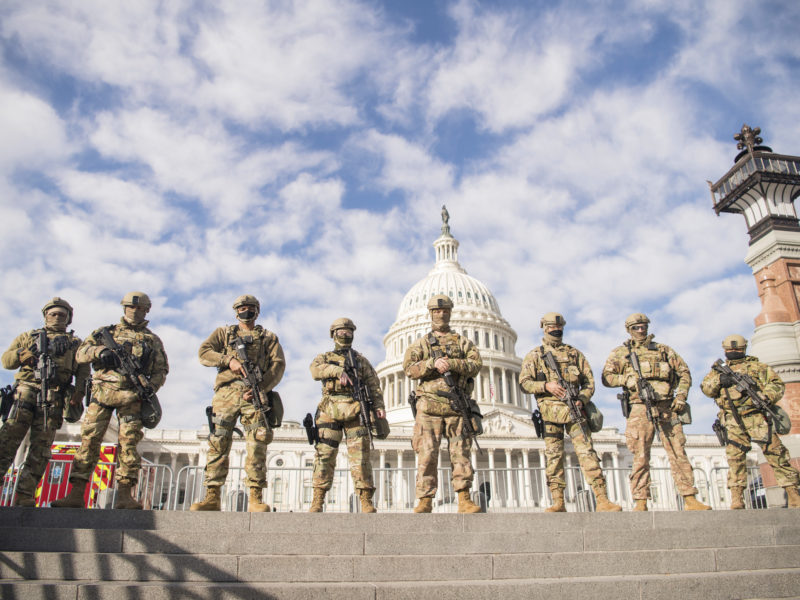By Joe Young
In the wake of violent riots, today the United States inaugurates the 46th president of the republic. It is taking place in unusual circumstances—Washington DC is on lockdown, 25,000 members of the National Guard are on patrol, schools are closed out of concern for violence, and a curfew may be imposed. This is not what we expect during a transition of power in the US. The violence around the election and the spectre of violence, Trump’s refusal to concede, and his incitement of a Capitol riot are worrying signs for the health of American democracy.
Recent analysis has rightly discussed America’s democracy crisis in light of the rise of the far right. An overlooked aspect of extremism, however, is that it can spark counter-extremism. Consider that the far-right movement—specifically militias—was born at a time when much of the violence and disruption in the United States was directed by far-left activists who were radicalized by the Vietnam War. (See Kathleen Belew’s book, Bringing the War Home.) In Days of Rage, Bryan Burrough chronicles the violent acts of the Weather Underground and other groups in this period as well as the escalation from nonviolent student protests to underground violent resistance.
The lesson from the Vietnam period is clear: extremism fed extremism. Radical leftists responded to state violence abroad with domestic violence directed at the state. The radical right, feeling betrayed by the state and the left, directed violence domestically at the left, immigrants, and the state.
The use of violence, both by the right and the left, was a violation of the basic democratic principle that we resolve our differences nonviolently. We do so at the ballot box, we do so through formal institutions like Congress via lobbying and legislation, we adjudicate this in the courts.
But as I wrote on January 7, democracy is a fragile equilibrium that can be disrupted—in the United States and anywhere else—by one party or group defecting and choosing violence.
Today, the violent rhetoric of Trump and his supporters coupled with the violence at recent protests and the Capitol riot, are degrading the quality of US democracy. Whether this will escalate depends on how and whether the “other side” responds, since conflict and war cannot occur unless two parties fight—otherwise, we call it one-sided violence, massacres, or genocide. So far, the majority of protests by the left have remained nonviolent. According to The Armed Conflict Location & Event Data Project (ACLED), 93 percent of the 2,400 protests held in the US between May and August of 2020 were nonviolent. Where violence occurred, it tended to be confined to blocks within unique protest locations, such as specific parts of Portland, Oregon.
With this in mind, what worries me the most is a violent response by the left in response to the extremism on the right. Take the example of Daniel Alan Baker, a former Army Airborne infantryman, who was recently arrested in Tallahassee, Florida for attempting to organize an assault on Florida Capitol far-right protestors. Baker has a history of violence—when he was discharged from the Army, he volunteered with the YPG or Kurdish militants engaged in fighting ISIS and Turkey. Baker’s story is a common one. As Jason Fritz and I found researching former and current volunteers, some are former military who were either discharged or angry that the job they were sent to do in Iraq was unraveling. Some fretted that these returned volunteers could be violent either against adversaries or the government. In Baker’s case, this seems to be accurate. Baker is anti-government and anti-Trump. And like the Oklahoma City bomber, Timothy McVeigh, he is trained and has combat experience and is thus likely to be more effective at violence.
To be clear, I don’t worry that the extreme left and antifa are better at violence and more likely to use it than the far right. What I worry about is escalation as both sides engage in tit-for-tat violence that spirals into larger more sustained conflict (one important recipe for civil conflict).
The good news is that one move to de-escalate the conflict has happened: Trump and his far-right allies have been banned from social media, removing conspiracy theories and calls to action (from some of its most effective messengers) from the world’s largest megaphone. The left and far left need to focus on de-escalation, too, and refuse to engage in street battles like in Portland. As Erica Chenoweth’s research shows, nonviolent resistance is more effective than the alternatives, and violence tends to delegitimize movements or parties in a conflict.
For the US to rebuild democracy, we need all sides to commit to nonviolence and to participate in free and fair elections. But just as important, we need at least one side to remain principled and refuse to respond to escalating violence by the other. To the far left’s credit, they stayed home during the Capitol riots, and have been much less violent overall. Hopefully they will remain so.








1 comment
You may have not intended to do so, but I think you have managed to express the state of mind that a lot of people are in. The sense of wanting to help, but not knowing how or where, is something a lot of us are going through.